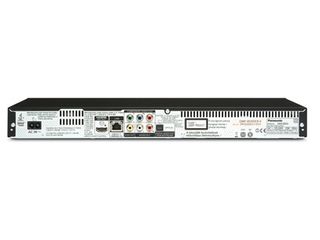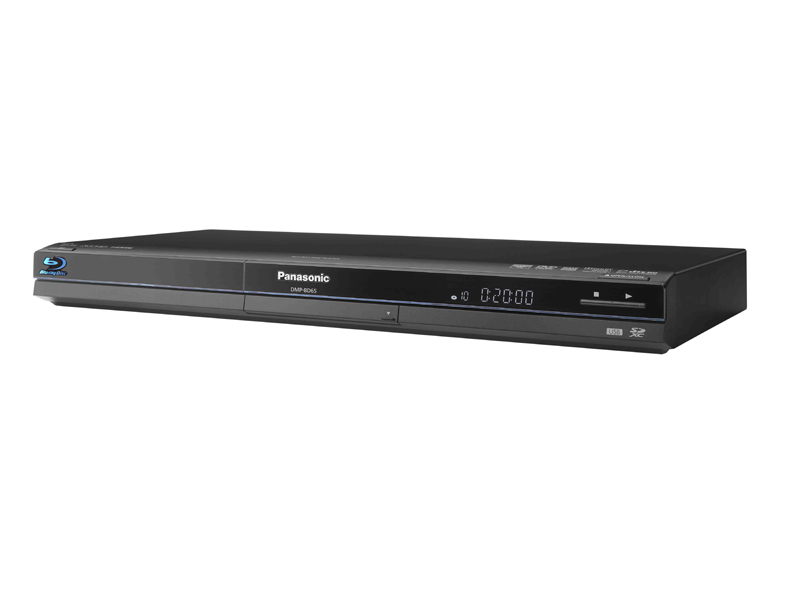Why you can trust TechRadar

Feature-wise the DMP-BD65 is just about on the money, though we'd have thought Panasonic's mature position in the market would lead to its engineers and designers knowing exactly what hi-def fans are after.
There's a rather fussy approach to both BD Live and Wi-Fi networking. Despite it earning Profile 2.0 status, the DMP-BD65 requires a SD card to be inserted that's at least 1GB in size to store BD-Live downloads.
This situation is nothing new, but shouldn't Blu-ray players have moved on from this by now to include some built-in storage? A single gigabyte would do the job.
Memory cards
Positioned centrally underneath a flap on the DMP-BD65's front, that SD card slot is otherwise well specified. It's able to take the next generation of SDXC memory cards that promise to eventually reach a staggering 2TB in size. The SD card slot also plays some digital media files.
Connecting to BD-Live requires the DMP-BD65 to be hooked up to a router using its rear-mounted Ethernet port, though a Wi-Fi dongle (the £79.99 DY-WL10) is available from Panasonic – again, not ideal.
Nor is the lack of DLNA networking, though on the brand's high-end DMP-BD85 this feature only covers the streaming of music and photos, not video, so you're not missing much.
Also depending on that Ethernet port – or dongle – is Viera Cast.
Online video content
This rather neat online portal is gorgeously designed and easily the best of its kind around, but for one tiny oversight; there's really nothing to watch. Content is king and Viera Cast hasn't progressed at all in the last 12 months since we reviewed the first batch of Viera Cast-endowed Blu-ray players.
Not that we want to see an online portal as streamlined as this crammed with icons and apps for the sake of it, but Panasonic had promised so much; videos from Daily Motion and Euro News, and even movies on-demand.
Streamed and rented films from Ace Trax has been mooted (Panasonic had planned to be the first to launch with a DRM-protected system), as has the ability to make Skype calls (though this is more likely to be an add-on to the brand's Viera TVs).
On-demand films would be welcome; in the States it's possible to stream content from Netflix and Amazon VOD on this very machine.
More to come
For now Viera Cast in the UK is saddled with empty slots on its home page, under content portals for Google's Picassa and YouTube. However, sign in to your online account and the instant appearance of your photo collections and slideshows via Picassa is excellent.
Similarly, looking for videos on YouTube – helped by a very suggestive search engine – is a cinch, as is skipping around the screen using the remote.
If its online ambitions are still in their infancy, the DMP-BD65's picture expertise is about as mature as it gets.
Arguably the chief feature on the DMP-BD65 is Panasonic's own picture processing suite, PHL Reference Chroma Processor Plus, which proves decisive. It also possesses Adaptive Chroma Upsampling, which is all about making colour as detailed and nuanced as possible – a critical skill with Blu-ray.
Equally important for those with home cinemas is the DMP-BD65's ability to decode the new audio formats found on Blu-ray discs – Dolby TrueHD and DTS-HD Master Audio Essential (as well as Dolby Digital Plus), which it can pipe into an amplifier over HDMI (if you're lucky enough to have an amp with HDMI ins) or optical digital audio cable as a PCM or bitstream signal. If you need quality 7.1-channel surround sound, head for the step-up DMP-BD85.
Last, but not least, the DMP-BD65 – like a lot of Panasonic disc spinners – can play DVD-RAM discs. So if you've archived a lot of TV programmes over the years using a Panasonic Diga DVD recorder, this could be the deck for you; you won't find RAM-compatibility any place else.
Current page: Page 2: Panasonic DMP-BD65: Features
Prev Page Page 1: Panasonic DMP-BD65 Next Page Page 3: Panasonic DMP-BD65: PerformanceJamie is a freelance tech, travel and space journalist based in the UK. He’s been writing regularly for Techradar since it was launched in 2008 and also writes regularly for Forbes, The Telegraph, the South China Morning Post, Sky & Telescope and the Sky At Night magazine as well as other Future titles T3, Digital Camera World, All About Space and Space.com. He also edits two of his own websites, TravGear.com and WhenIsTheNextEclipse.com that reflect his obsession with travel gear and solar eclipse travel. He is the author of A Stargazing Program For Beginners (Springer, 2015),

Testing Samsung's new AI-powered vacuum taught me that I don't really need my vac to be know the difference between every single surface

I’ve used a lot of power banks, but the Baseus Blade Pro is the only one slim enough for my laptop sleeve

This is the world's first Thunderbolt 5 LTO tape drive and I can't understand why it exists in the first place









